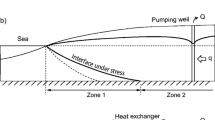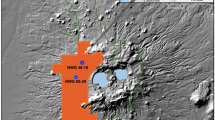Abstract
Use of well doublets for groundwater-sourced heating or cooling typically results in a “thermal plume” of cool or warm reinjected groundwater. Such a plume may be regarded either as a potential anthropogenic geothermal resource or as pollution, depending on downstream aquifer usage. A thermal plume may pose an external risk to downstream users and environmental receptors or an internal risk to the sustainability of the well doublet, due to the phenomenon of thermal feedback. A three-tier assessment of the risk of thermal feedback is proposed, based on: (1) consideration of well separation and yield; (2) analytical modelling of heat migration in a doublet to ascertain breakthrough time and post-breakthrough temperature evolution and (3) numerical modelling of complex scenarios.
Résumé
L’utilisation de puits en doublet avec injection d’eaux chaudes ou froides dans les eaux souterraines a pour conséquence l’existence d’un panache thermique froid ou chaud dans les eaux souterraines. Un tel panache peut être considéré soit comme une ressource géothermique anthropique potentielle, soit comme une pollution, en fonction de l’utilisation de l’aquifère à l’aval hydraulique. Un panache thermique peut engendrer un risque externe pour les usagers de l’eau souterraine à l’aval du point de réinjection ainsi que pour les récepteurs environnementaux et un risque interne pour la durabilité du puits doublet, lié aux phénomènes de réactions thermales. Une tierce évaluation du risque des réactions thermales est proposée, basée sur : (1) la considération de la séparation du puits et de sa production ; (2) un modèle analytique de la migration de la chaleur dans un doublet afin de définir le temps de restitution et l’évolution de la température après restitution et (3) un modèle numérique pour des scénarios complexes.
Resumen
El uso de pozos pares para calentamiento o enfriamiento de las aguas subterráneas típicamente da como resultado una “pluma térmica” de frío o calor en el agua subterráneas reinyectada. Tal pluma puede ser vista como un recurso geotérmico potencial de origen antrópico o como una contaminación, dependiendo del uso del acuífero aguas abajo. Una pluma térmica puede presentar un riesgo externo a los usuarios y receptores ambientales aguas abajo o un riesgo interno para la sustentabilidad de los pozos pares, debido al fenómeno de realimentación térmica. Se propone una evaluación de riesgo de nivel 3 de la realimentación térmica, basada en: (1) consideración de la separación entre los pozos y el rendimiento; (2) modelado analítico de la migración del calor para determinar el tiempo de ruptura y post ruptura de la evolución de la temperatura y (3) modelado numérico de escenarios complejos.
Resumo
A utilização de dispositivos de pares de poços para aquecimento ou arrefecimento de ambientes com base na circulação de água subterrânea em aquíferos provoca tradicionalmente uma pluma de água subterrânea fria ou quente re-injectada. Essa pluma pode ser considerada quer como um potencial recurso geotérmico antropogénico ou como um foco de poluição, dependendo do uso que se quiser dar ao aquífero a jusante do local de operação. Essa pluma térmica pode originar um risco externo aos utilizadores que estão a jusante e aos receptores ambientais ou um risco interno à sustentabilidade do dispositivo, devido a um fenómeno de resposta térmica. Neste trabalho é proposta uma metodologia de avaliação do risco térmico, que engloba 3 fases, baseadas na: (1) consideração da separação entre os poços e a sua produtividade; (2) modelação analítica do fenómeno de migração de calor no dispositivo de par de poços, de modo a determinar o tempo de ruptura e a evolução da temperatura pós-ruptura e (3) modelação numérica de cenários complexos



Similar content being viewed by others
References
Ampofo F, Maidment GG, Missenden JF (2004) Review of groundwater cooling systems in London. Appl Therm Eng 26:2055–2062
Andersson O (1998) Heat pump supported ATES applications in Sweden. IEA Heat Pump Centre Newslett 16(2):20–21
Bakema G, Snijders A (1998) ATES and ground-source heat pumps in the Netherlands. IEA Heat Pump Centre Newslett 16(2):15–17
Ball DA, Fischer RD, Talbert SG, Hodgett D, Auer F (1983) State-of-the-art survey of existing knowledge for the design of ground source heat pump systems. Report ORNL/Sub 80-7800/2, Battelle Columbus Laboratories, Columbus, Ohio, 75 pp
Banks D (2007) Thermogeological assessment of open loop well doublet schemes: an analytical approach. Proc. 27th Annual Conference of the Irish Group of the International Association of Hydrogeologists, Tullamore, Ireland, 24–25 April 2007
Banks D (2008) An introduction to thermogeology: ground source heating and cooling. Blackwell, Oxford, 339 pp
Bodvarsson G (1972) Thermal problems in the siting of reinjection wells. Geothermics 1(2):63–66
Clauser C (ed) (2003) Numerical simulation of reactive flow in hot aquifers: SHEMAT and Processing SHEMAT. Springer, Berlin, 332 pp
Clyde CG, Madabhushi GV (1983) Spacing of wells for heat pumps. J Water Resour Plan Manage 109(3):203–212
De Marsily G (1986) Quantitative hydrogeology: groundwater hydrology for engineers. Academic, Orlando, FL, pp 277–283
Domenico PA, Schwartz FW (1990) Physical and chemical hydrogeology. Wiley, New York, 824 pp
EA (2006) Groundwater levels in the Chalk-Basal Sands aquifer of the London Basin: June 2006. Environment Agency (Thames Region), Reading, UK
Ferguson G, Woodbury AD (2005) Thermal sustainability of groundwater-source cooling in Winnipeg, Manitoba. Can Geotech J 42:1290–1301
Fry V, Kelly T (2008) Management of the London Basin Chalk aquifer: status report 2008. Environment Agency report ea/br/e/std/v1, Environment Agency, Bristol, UK
Gringarten AC (1978) Reservoir lifetime and heat recovery factor in geothermal aquifers used for urban heating. Pure Appl Geophys 117(1–2):297–308
Gringarten AC, Sauty JP (1975) A theoretical study of heat extraction from aquifers with uniform regional flow. J Geophys Res 80:4956–4962
Grove DB (1971) US Geological Survey tracer study, Amargosa Desert, Nye County, Nevada, part II: an analysis of the flow field of a discharging-recharging pair of wells. US Geol Surv Rep USGS-474-99, 56 pp
Güven O, Falta RW, Molz FJ, Melville JG (1986) A simplified analysis of two-well tracer tests in stratified aquifers. Ground Water 24(1):63–71
Hoopes JA, Harleman DR (1967) Wastewater recharge and dispersion in porous media. J Hydraul Div ASCE 93/HY5:51–71
Kazmann RG, Whitehead WR (1980) The spacing of heat pump supply and discharge wells. Ground Water Heat Pump J 1(2):28–31
Kelley I (2006) Ground-source heat pumps deliver both high efficiency and reliability: good news for both contractors and their customers. Wisconsin Perspect Sept.–Oct. 2006, pp 14–16
Kipp KL (1997) Guide to the revised heat and solute transport simulator: HST3D - version 2. US Geol Surv Water-Resour Invest Rep 97-4157, 149 pp
Law R, Nicholson D, Mayo K (2007) Aquifer thermal energy storage in the fractured London Chalk: a thermal injection/withdrawal test and its interpretation. , Paper SGP-TR-183, Proceedings of the 32nd Workshop on Geothermal Reservoir Engineering, Stanford University, CA, 22–24 Jan 2007
Lippmann MJ, Tsang CF (1980) Groundwater use for cooling: associated aquifer temperature changes. Ground Water 18(5):452–458
Luxiang S, Manfang B (1984) Case History No. 9.2; Shanghai, China. In: Poland JF (ed) Guidebook to studies of land subsidence due to ground-water withdrawal. UNESCO Stud Rep Hydrol 40:155–160
Shook GM (2001a) Predicting thermal velocities in fractured media from tracer tests. Idaho National Laboratory, Idaho Falls, ID, USA. http://geothermal.id.doe.gov/publications/articles/shookgrcpaper01.pdf. Cited December 2008
Shook GM (2001b) Predicting thermal breakthrough in heterogeneous media from tracer tests. Geothermics 30(6):573–589
Spitler JD (2005) Ground source heat pump system research: past, present and future. Int J HVAC&R Res 11(2):165–167
Todd FK (2008) Impact assessment of a warm water discharge in the Sherwood Sandstone at Selby, North Yorkshire. MSc Thesis, University of Leeds, UK, 82 pp
Tsang CF, Lippmann MJ, Witherspoon PA (1977) Production and reinjection in geothermal reservoirs. Trans Geotherm Resour Coun 1:301–303
Volker A, Henry JC (1988) Side effects of water resources management: overviews and case studies. A contribution to IHP Project 11.1.a, prepared by a working group for IHP-III. IAHS Publication 172, IAHS, Wallingford, UK
Vos L (2007) Underground thermal energy storage in the Netherlands. Proc. 27th Annual Conference of the Irish Group of the International Association of Hydrogeologists, Tullamore, Ireland, 24–25 April 2007, pp 4–24
Author information
Authors and Affiliations
Corresponding author
Rights and permissions
About this article
Cite this article
Banks, D. Thermogeological assessment of open-loop well-doublet schemes: a review and synthesis of analytical approaches. Hydrogeol J 17, 1149–1155 (2009). https://doi.org/10.1007/s10040-008-0427-6
Received:
Accepted:
Published:
Issue Date:
DOI: https://doi.org/10.1007/s10040-008-0427-6




